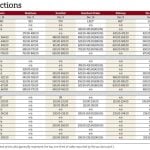Chicago | Reuters—Chicago soybean futures rose on Tuesday ahead of a meeting between a coalition of oil and biofuel groups and the U.S. Environmental Protection Agency to discuss raising federal mandates for biomass diesel blending.
Corn and wheat futures followed the oilseed down, with corn gaining support from wet forecasts in the U.S. delta and Ohio Valley, according to analysts, and wheat gaining on reduced acreage in a U.S. Department of Agriculture report released on Monday.
The most active soybean contract Sv1 on the Chicago Board of Trade was up 16-3/4 cents at $10.31-1/2 per bushel at 11:38 a.m. CST. (1638 GMT), having hit its highest point since March 6. CBOT corn Cv1 added 4-1/2 cents to $4.61-3/4 a bushel, and wheat Wv1 gained 4-1/2 cents to $5.41-1/2 a bushel.
Read Also

Pulse Weekly: No upside for peas until after New Year
Prices for green and yellow peas have dropped back across the Prairies over the last week. One of the major downward drivers was the Statistics Canada production report released earlier this month, said Levon Sargsyan of Johnston’s Grain in Calgary.
News that a newly formed coalition of oil and biofuel groups, including the American Petroleum Institute, were meeting with EPA officials on Tuesday drove soybean and soyoil futures up on Tuesday, said Jim McCormick, founding partner at AgMarket.net.
The coalition is pushing for higher biomass diesel blending mandates in the range of 5.5 billion to 5.75 billion. “That would be up dramatically from the current 3.55 billion,” said McCormick.
Corn also took support from near-term forecasts for heavy rain in the U.S. Delta and Ohio River Valley, said McCormick.
“It’s not a huge problem yet, but we’re obviously not going to get off to a very fast start planting in that portion of the country,” he said.
And in wheat, futures continued to rise on momentum from Monday’s prospective planting data released by the USDA.
The planting forecast estimated the 2025 U.S. wheat area below a range of analyst estimates.
Still, grain markets were bracing for U.S. President Donald Trump’s announcement of reciprocal tariffs on April 2, a prospect that continues to raise concern over retaliation against U.S. farm exports, according to McCormick.
—Additional reporting by Gus Trompiz in Paris and Ella Cao and Mei Mei Chu in Beijing














